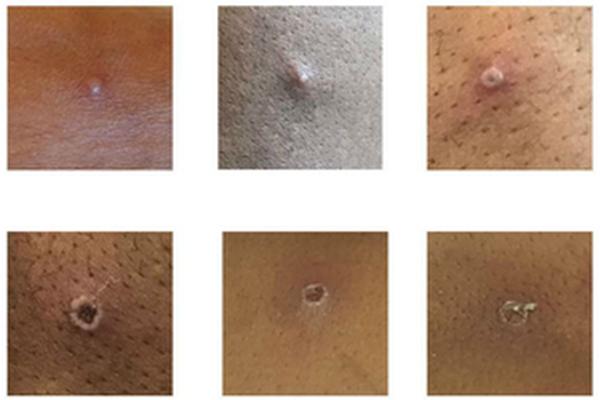- 📖 Geeky Medics OSCE Book
- ⚡ Geeky Medics Bundles
- ✨ 1300+ OSCE Stations
- ✅ OSCE Checklist PDF Booklet
- 🧠 UKMLA AKT Question Bank
- 💊 PSA Question Bank
- 💉 Clinical Skills App
- 🗂️ Flashcard Collections | OSCE, Medicine, Surgery, Anatomy
- 💬 SCA Cases for MRCGP
To be the first to know about our latest videos subscribe to our YouTube channel 🙌
Introduction
MPox (previously known as monkeypox) is a rare zoonotic disease caused by the monkeypox virus (MPV), which belongs to the genus Orthopoxvirus, along with variola virus, the causative agent of smallpox.1,2
MPV has emerged as the most important Orthopoxvirus for public health and has caused an ongoing outbreak in the UK, beginning in May 2022.3
This article presents a clinical summary of MPV, including its epidemiology, clinical features, and management.
Epidemiology
MPV is endemic to the Democratic Republic of Congo, where the virus was first isolated in 1970.2
There are two clades of the virus: the Central African (Congo Basin) clade, and the West African clade.1 The former is more prone to cause severe disease, with a case-fatality ratio (CFR) of up to 11%, whereas the latter has a CFR of <1%.
Since the eradication of smallpox in 1980, MPV has emerged as the most important Orthopoxvirus for public health, and incidence may be exacerbated by waning immunity following the cessation of smallpox vaccination, which conferred 85% protection to MPV.2
Prior to 2003, outbreaks of MPV were limited to Africa, with cases reported in 10 countries. The first outbreak outside of Africa occurred in 2003 when a shipment of wild rodents from Ghana is thought to have infected pet prairie dogs in the USA.2
Over the following years, cases were reported in Israel, the UK, and Singapore.4
2022 MPox outbreak
An ongoing outbreak began in the UK following a confirmed case in a patient returning from Nigeria. Between 7th and 25th May, 71 cases were identified in the UK and over 200 cases have been reported in more than 20 countries across Europe, Australia, and America.3.5
A notable proportion of cases were identified among men-who-have-sex-with-men (MSM), although this is thought to be transmitted through close contact, not sexual transmission. 6
A World Health Organization (WHO) risk assessment has stated that the risk of potential onward spread in the UK is minimal owing to the rapid public health response including isolation and contact tracing, however, the source of infection in Nigeria has not been determined, so there remains a risk of further transmission.7
For the latest information, see the UK Health Security Agency information pages on monkeypox.
Aetiology
The monkeypox virus (MPV) is a double-stranded DNA virus belonging to the genus Orthopoxvirus. This group contains four other virus species pathogenic to humans, including cowpox virus, vaccinia virus, and variola virus, the causative agent of smallpox.1,2
Pathophysiology8
MPV, and other species of Orthopoxvirus, bind to the cell surface through interaction between their ligands and several different cell surface receptors, before gaining entry via fusion or endosomal uptake.
Replication occurs in the cytoplasm of cells at the site of infection, where pre-made viral proteins stimulate the expression of early genes which promote DNA replication, as well as transcription and translation of intermediate and late genes, which code for structural proteins. Thus, nascent virions are assembled and spread to lymph nodes.
MPV has an incubation period of 7-17 days before the onset of symptoms.
Transmission9
Transmission occurs when the virus gains access through broken skin, the respiratory tract or the mucous membranes. MPV is zoonotic, and although the host reservoir is still unknown, species of African rodents are implicated.
Animal-human transmission occurs through direct contact with blood, bodily fluids, or cutaneous or mucosal lesions of infected animals.
Human-human transmission is rarer and occurs through saliva and respiratory excretions, direct and indirect contact with lesion exudate or crust material or vertical transmission via the placenta, or close contact during or after birth.
Risk factors
Individuals who have travelled to endemic countries and been in contact with infected individuals or animals are at increased risk of acquisition.
Immunocompromised individuals, such as children and pregnant women often have more severe disease, along with those with underlying immune deficiencies.
People younger than 40-50 may be more susceptible due to the cessation of smallpox vaccination.7
Clinical features
The disease is often self-limiting, with symptoms usually resolving within 2-4 weeks. The clinical features associated with MPox infection mirror that of smallpox.
The prodromal phase lasts between 1-4 days and includes fever, headaches and fatigue.1,2
Importantly, a distinctive feature of MPV infection is maxillary, cervical or inguinal lymphadenopathy (maxillary, cervical or inguinal), which is absent in similar diseases such as chickenpox, measles, and smallpox.7
Around 1-3 days following the prodromal phase, a distinctive rash appears, with the number of lesions varying significantly.1,2 This characteristically appears on the face before taking a centrifugal distribution1, with the following body parts affected: 9
- Face (95%)
- Palms of hand and soles of feet (75%)
- Genitalia (30%)
- Conjunctiva/cornea (20%)
The lesions, shown in Figure 1, develop sequentially from macules to papules and to vesicles (1A) containing clear fluid.10
Vesicles then become well-circumscribed, umbilicated pustules (1B, 1C) before ulcerating (1D) and crusting over (1E, 1F). The infection can last up to 4 weeks until the lesions desquamate.1.2

Differential diagnoses
The WHO recommends suspecting MPox in any person in a non-endemic country with an unexplained acute rash accompanying either headache, acute onset fever, lymphadenopathy, myalgia, back pain or asthenia if the rash cannot be explained by more common causes, such as chickenpox, shingles and herpes simplex. 4
Table 1. Differential diagnoses for MPox.1,2,11
| Differential diagnosis | Discerning features |
|
Smallpox |
|
|
Varicella-zoster virus (VZV, chickenpox) |
|
|
Herpes zoster virus (HZV, shingles) |
|
|
Herpes simplex virus (HSV) |
|
Diagnosis
Diagnosis of MPV relies on the detection of viral DNA using PCR testing.4
Samples should be obtained from swabbing the roof, fluid, or crust of skin lesions. Antigen detection and antibody serology testing are not recommended for the diagnosis of MPV due to their cross-reactivity with other orthopoxviruses.
Management
In the first instance, patients with suspected MPox should be isolated, and given supportive care.
Antivirals may be used such as cidofovir, a DNA polymerase-inhibitor, and tecovirimat, which inhibits the viral envelope protein.11
Prevention
WHO recommends reporting illnesses associated with travel to endemic countries, avoiding contact with infected animals and avoiding eating or handling bushmeat, as well as using hand hygiene and alcohol-based sanitiser.4
Prompt contact tracing and surveillance protocols should be employed to curb onward transmission. Health workers should observe contact and droplet infection control precautions. 12
Although prior smallpox vaccination confers 85% protection against MPox, populations under the age of 50 may no longer benefit due to its cessation following the eradication of smallpox.
The UK Health Security Agency (UKHSA) is offering the smallpox vaccine Imvanex to high-risk contacts of patients diagnosed with MPox to reduce symptomatic infection and severe illness. 3
Complications
Severe complications are more common among unvaccinated (74%) than vaccinated (39.5%) patients; bacterial skin infections were noted in 19% of unvaccinated MPox patients, and other complications may include bronchopneumonia, vomiting, diarrhoea, and dehydration.1,2
Other complications include ocular infections, loss of vision and sepsis in severe cases. Congenital MPV and stillbirth can occur in pregnant women.
Key points
- MPox is a rare zoonotic disease caused by the monkeypox virus (MPV)
- MPV has caused an ongoing outbreak in the UK, however, a WHO risk assessment has stated that the risk of potential onward spread in the UK is minimal
- MPV is transmitted from animals to humans through direct contact with blood, bodily fluids, or cutaneous or mucosal lesions of infected animals.
- Human-to-human transmission is rarer and occurs through saliva/respiratory excretions, contact with lesion exudate or crust material or vertical transmission via the placenta, or close contact during or after birth
- Risk factors include travel to endemic countries, contact with infected individuals or animals, and immunocompromised states
- The disease is often self-limiting. Symptoms include fever, headaches, and fatigue before the appearance of a rash
- Lesions appear most commonly appear on the face and peripheral body parts and develop sequentially into vesicles and pustules which ulcerate and crust over
- Diagnosis requires lesion swabs and PCR testing
- Management is largely supportive, but antivirals such as cidofovir and tecovirimat may be used, and smallpox vaccines may be offered to high-risk contacts
- Common complications include bacterial skin infections, bronchopneumonia, vomiting, diarrhoea, and dehydration.
Editor
Dr Chris Jefferies
References
- McCollum AM, Damon IK. Human monkeypox. Clinical infectious diseases. 2014 Jan 15;58(2):260-7.
- Sklenovska N, Van Ranst M. Emergence of monkeypox as the most important orthopoxvirus infection in humans. Frontiers in public health. 2018 Sep 4;6:241.
- UK Health Security Agency. GOV.UK. 2022. Monkeypox cases confirmed in England – latest updates. [Accessed 25 May 2022] Available from: [LINK]
- World Health Organization (21 May 2022). Disease Outbreak News; Multi-country monkeypox outbreak in non-endemic countries. Available from: [LINK]
- GOV.UK. 2022. Monkeypox cases confirmed in England – latest updates. [Accessed 25 May 2022] Available from: [LINK]
- Kozlov M. Monkeypox goes global: why scientists are on alert. Nature. 2022 May 20. doi: 10.1038/d41586-022-01421-8. Epub ahead of print. PMID: 35595996.
- World Health Organization (16 May 2022). Disease Outbreak News; Monkeypox– United Kingdom of Great Britain and Northern Ireland. Available at: [LINK]
- Alkhalil A, Hammamieh R, Hardick J, Ichou MA, Jett M, Ibrahim S. Gene expression profiling of monkeypox virus-infected cells reveals novel interfaces for host-virus interactions. Virology Journal. 2010 Dec;7(1):1-9.
- World Health Organization (21 May 2022). Disease Outbreak News; Multi-country monkeypox outbreak in non-endemic countries. Available from: [LINK]
- UK government. Stages of lesion development. License: [OGL]
- BMJ Best Practice. Poxvirus infection (monkeypox and smallpox) – Differentials. Available from: [LINK]
- UK Health Security Agency. GOV.UK. 2022. Monkeypox: background information. [Accessed 25 May 2022] Available from: [LINK]




